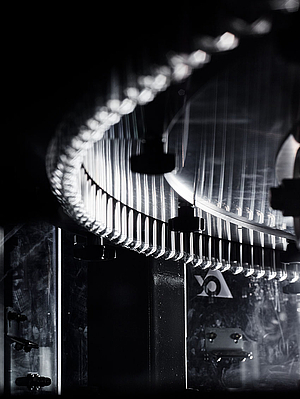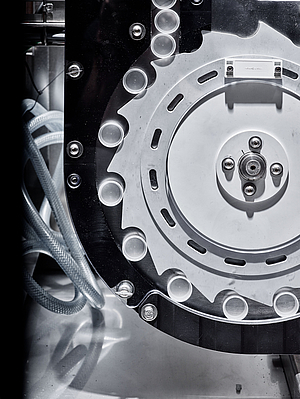

Photo credit: SIDEL
The smart Sidel Super Combi brings equipment intelligence to today‘s production

Consumer preferences are broadening and overall demand is increasing due to unprecedented population growth, increased consumer spending power and growing demand for personalisation of products in terms of design and taste. The ability of production solutions to satisfy output requirements for new products efficiently, while implementing technologies that improve long-term viability, has become vital to manufacturers’ success. To address these challenges, Sidel introduces Super Combi, designed and engineered as a single smart solution for water and CSD producers.
Sidel Super Combi integrates five process steps: preform feeder, blower, labeller, filler/capper and cap feeder. To deliver a self-optimising performance and increased long-term value, it combines intelligent automation with innovative technologies of connected machines and data-analytics management, leading to optimised production and maintenance services.
This next generation solution puts a focus on the product quality, differentiated branding options, and flexibility in production, while reducing total costs of ownership (TCO). Moreover, via its data-driven intelligence and advanced automation, Super Combi helps achieve the optimum performance easily and continuously across the entire production process, ensuring maximised uptime and production output at high or very-high speeds (up to 81,000 bph).
A SMARTER SOLUTION FOR TODAY’S DEMANDS
For big players in the water and CSD markets, supplying high-quality products to major retailers from their many plants – in a profitable way - has become vital for their success. This is even more critical if the number of SKUs they are handling is very high: they need production solutions that are able to satisfy output requirements for new products efficiently and easy- to-use technologies that improve long- term viability. This is also a main goal for Niagara Bottling LLC, a large supplier of low-cost, high-quality water in the US and Mexico. With more than 15 complete PET lines from Sidel installed at their production sites, the company recently decided to acquire a new high-speed PET line, including two Super Combis, to be able to deliver both performance and cost-efficiency.
Their choice is based on the positive trajectory the PET bottled water segment is showing in the US: it is expected to grow by a CAGR (compound annual growth rate) of 3% year on year between 2016 and 2020 (1). Already producing bottled water for Niagara’s markets, the Super Combis allow this bottler to increase efficiency through high-speed manufacturing and data management, used to guide information assessment and decision-making – from operator to management level.
As shown by the Niagara case, all in all beverage producers simply want a solution that does the thinking for them and acts on their behalf. Such autonomous regulation is, for instance, achieved via Sidel Intelli-adjustTM, able to control the system’s performance and automatically apply adjustments, wherever they are needed. Augmented reality guidance and GPS localisation are two examples of intuitive interfaces that help customers reduce maintenance time, minimise downtime and thus lead to long-term improvement of their performance.
In addition, for improved reactivity of the operator, Super Combi has an automated alert system to provide advanced timely reportedly EITTM (Efficiency Improvement Tool) audio and smart portables, on events such as changeovers, label or cap shortages and possible faults. Improved Root Cause Analysis (RCA) software enables intuitive intervention, thus facilitating the solution of these problems. By ‘learning from experience’, the Sidel InUse platform has the ability to calculate and predict possible future failures and optimise maintenance plans. This helps to speed up problem solving and offers the chance of timely detection of possible issues, as well as guidance for their successful resolution. The Super Combi also provides real-time access to the Sidel Big Data repository - where customer data is safely held under conditions of total cyber security - for refining its own prediction algorithms. This makes it possible to maintain, control and even improve the performance of main components and modules.

THE LOWEST PRODUCTION COST PER SQUARE METRE
Waste reduction and minimisation of resources are two of the key driving factors in the design of the Super Combi, as sustainability is high on the agenda of liquid packaging producers. For example, the Super Combi blower, which is based on the Sidel MatrixTM platform, operates at a high oven efficiency and minimal environmental footprint, while still pushing the boundaries of ultra-lightweight bottle production and handling, thanks to the labelling process that is now integrated in the solution. This couples with the reduction of consumed electrical power by up to 45%, minus 15% preform-heating time and, with the option of AirEco2 double air-recovery, a 35% reduction in the use of compressed air. To further lower the environmental footprint, the new melter and glue control distribution on the labeller minimises the consumption of raw material. Additionally, the OptiFeed® cap feeder system from Gebo Cermex, part of the Sidel Group, combines storage, elevation, orientation and high-speed feeding with energy savings, as its individual cap-elevating technology eliminates the need for compressed air and electronic fan systems during extraction.
Niagara Bottling has always been focused on LEAN production methods. With the Super Combi, the bottler recognised how this new solution’s compact footprint and optimised raw material management could allow them to further reduce waste. Bill Hall, Executive Vice President of Manufacturing at Niagara Bottling LLC, emphasizes this point, “Our focus is always going to be on reducing Total Cost of Ownership (TCO). Our goal is to deliver a case of water to our customers, while removing any component and process that is not bringing added value to them. The Super Combi is letting us take the next step in that evolution.” He continues, “With the Super Combi, we have a blower, labeller and filler in one compact machine. This reduces inefficiencies, meaning we have fewer machines to maintain and a smaller working space to be controlled by less skilled operators. In this way, we can clearly drive down costs.”
Ensuring operator access is immediate and safe, while allowing for ongoing high levels of performance, is in fact a key design component for manufacturers in the beverage market today. This is why – in the Super Combi - the EasyFEED preform feeder is located at ground level, while the labeller and cap feeder have all been designed for easier and more ergonomic operator access. Engineered to maximise ease of operation, with its intuitive interfaces, ergonomic design and clear guidance on operations and maintenance activities, the solution is up to 30% smaller, compared to standalone equipment. This significantly reduced footprint, combined with enhanced visibility of all blocks, makes single-operator control possible.
For US customers, this means they can continue to enjoy the best value and highest quality bottled water on the shelves, while Niagara is able to address the changing trends on the beverage market with the help of a flexible, reliable and more sustainable cutting-edge bottling solution.

SAFER AND MORE HYGIENIC
Besides flexibility, speed and reliability, food safety is another critical requirement for liquid packaging producers. From the start of the line, Sidel Super Combi ensures maximum packaging quality by gently handling the preforms via the preform feeder. Similarly, positive handling of the bottles by the neck throughout the whole system and across a safe environment - from blowing to capping - guarantees optimal care and strict hygiene. This enables higher bottle quality overall, ensures beverage integrity and maximises lightweighting opportunities. The integrated vision/rejection systems – controlling every step of the production process - further ensure the best product quality, saving both raw materials and consumption of resources.
ULTIMATE FLEXIBILITY FOR IMPROVED UPTIME
The integration of innovative new technologies minimises changeovers on the Sidel Super Combi, which can be guided for improved speed and efficiency to keep the line running smoothly with minimal downtime. The simplified settings of the preform feeder, the quick release blowing moulds and a reliable high-speed reel auto-splicer, along with the sector based vacuum drum of the labeller, are just some of the ways that Sidel Super Combi makes changeovers easier and faster than ever.

REDUCE DOWNTIME VIA INNOVATIVE LABELLING FLEXIBILITY
Continuous uptime is vital for high- output production of beverages producers at high and very-high speeds. To overcome typical challenges, Sidel has been applying an extensive innovation and improvement process aimed at re-engineering the company’s existing labelling technology. With the Super Combi, the labelling process is highly efficient, while providing unmatched process flexibility, thanks to different machine configurations based on the required output. The integrated labeller is able to carry out different labelling processes, including the application of PSL (pressure sensitive labels) and roll-fed labels.
Super Combi’s labelling process can be optimised to work with up to three stations running simultaneously, or it can be configured into a double aggregate with a ‘master/slave’ setup, in which one or two stations run, while the designated ‘slave’ station remains idle – still achieving the nominal output. When a reel-change is required, the roles automatically switch. This results in a labelling process that delivers uncompromising continuous high-speed production with neither product loss nor a reduction in speed of production, resulting from reel- changes.
By utilising integrated equipment intelligence and innovative technologies from Sidel, the Super Combi enables continuous production-optimisation and enhanced performance for producers of PET bottled water and CSD. This makes it the ideal way to strengthen production capabilities, boost speed and increase line efficiency while reducing TCO.
A SNAPSHOT OF THE BOTTLED WATER MARKET
Throughout the world, sugar backlash, taxes on sugar-sweetened products to help fight obesity, transition to healthier lifestyles and consumer concern about safety of tap water offer tremendous potential for the bottled water market, already representing 334 Bn units, and expected to increase by 5% CAGR (Compound Annual Growth Rate) (2). Greater China (GC), Greater Middle East & Africa (GMEA) and South East Asia Pacific (SEAP) lead the growth of this category.
Overall, the water segment is getting more and more sophisticated. With a deeper look, we can observe the following trends:
- Suits me: healthy lifestyle drives natural food and drink consumption and healthy hydration, moving volumes from carbonated soft drinks (CSDs) and fruit juice to plain water as well as flavoured and functional waters; the latter ones particularly suitable for rehydration after sport
- Suits my senses: experience-based consumption is behind the development of ‘premium’ solutions, new fla- vours for water, and personalisation through label and decoration, caps and secondary packaging. Premium water products are estimated to repre- sent 6% of the bottled water market, with the highest presence in Europe & Central Asia (ECA) and SEAP (18% and 4% of these markets respectively) (3)
- Suits my lifestyle: on-the-go, active lifestyle pushes manufacturers to downsize bottles, adopt drink-from closures, and establish their brands via multiple distribution channels to reach moving consumers. This trend drives development of solutions to address the needs of different demographic segments, such as children (attracted via “baby water”, bottled in small and ergonomic containers and coming with spout closures) and elderly people (who can leverage targeted water products and ergonomic bottle designs)
- Suits nature: environmentally con- scious consumption drives consum- ers’ preference for organic water, origin-controlled/certified water, bio- based bottle polymers, recycled con- tent materials
- Suits my budget: the search for best value drives the introduction of simple and affordable solutions, basic and lightweight bottles, and reduction of costs across the value chain. Commodity water is estimated to be 37% of the bottled water market, with the highest presence in North America (NA), GC and SEAP (63%, 55% and 46% of these markets, respectively) (4)
The majority of the water category – where PET is the most largely used packaging material (87%) - is represented by still water (88% vs. 22% sparkling water), with an expected 6% CAGR in the timeframe 2017-2020 (5).
(1), (2), (3), (4), (5) Euromonitor International
The comPETence center provides your organisation with a dynamic, cost effective way to promote your products and services.

magazine
Find our premium articles, interviews, reports and more
in 3 issues in 2025.




